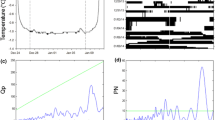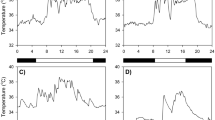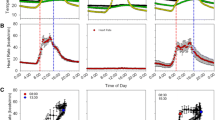Abstract
Hibernation is a strategy of reducing energy expenditure, body temperature (T b) and activity used by endotherms to escape unpredictable or seasonally reduced food availability. Despite extensive research on thermoregulatory adjustments during hibernation, less is known about transitions in thermoregulatory state, particularly under natural conditions. Laboratory studies on hibernating ground squirrels have demonstrated that thermoregulatory adjustments may occur over short intervals when animals undergo several brief, preliminary torpor bouts prior to entering multiday torpor. These short torpor bouts have been suggested to reflect a resetting of hypothalamic regions that control T b or to precondition animals before they undergo deep, multiday torpor. Here, we examined continuous records of T b in 240 arctic ground squirrels (Urocitellus parryii) prior to hibernation in the wild and in captivity. In free-living squirrels, T b began to decline 45 days prior to hibernation, and average T b had decreased 4.28 °C at the onset of torpor. Further, we found that 75 % of free-living squirrels and 35 % of captive squirrels entered bouts of multiday torpor with a single T b decline and without previously showing short preliminary bouts. This study provides evidence that adjustments in the thermoregulatory component of hibernation begin far earlier than previously demonstrated. The gradual reduction in T b is likely a component of the suite of metabolic and behavioral adjustments, controlled by an endogenous, circannual rhythm, that vary seasonally in hibernating ground squirrels.




Similar content being viewed by others
References
Arai S, Hanaya T, Sakurai T, Ikeda M, Kurimoto M (2005) A novel phenomenon predicting the entry into a state of hibernation in Syrian hamsters (Mesocricetus auratus). J Vet Med Sci 67:215–217
Arnold W, Ruf T, Frey-Roos F, Bruns U (2011) Diet-independent remodeling of cellular membranes precedes seasonally changing body temperature in a hibernator. PLoS ONE 6:e18641
Barnes BM (1989) Freeze avoidance in a mammal: body temperatures below 0 °C in an Arctic hibernator. Science 244:1593–1595
Barnes BM (1996) Relationships between hibernation and reproduction in male ground squirrels. In: Geiser F, Hulbert AJ, Nicol SC (eds) Adaptations to the cold: tenth International Hibernation Symposium. University of New England Press, Armidale, pp 71–80
Barnes BM, Ritter D (1993) Patterns of body temperature change in hibernating arctic ground squirrels. In: Carey C, Florant GL, Wunder BA, Horwitz B (eds) Life in the cold: ecological, physiological, and molecular mechanisms. Westview Press, Boulder, pp 119–130
Barnes BM, Kretzmann M, Zucker I, Licht P (1988) Plasma androgen and gonadotropin levels during hibernation and testicular maturation in golden-mantled ground squirrels. Biol Reprod 38:616–622
Buck CL, Barnes BM (1999) The annual cycle of body condition and hibernation in free-living arctic ground squirrels. J Mammal 80:430–442
Buck CL, Barnes BM (2000) Effects of ambient temperature on metabolic rate, respiratory quotient, and torpor in an arctic hibernator. Am J Physiol Regul Integr Comp Physiol 279:R255–R262
Buck CL, Breton A, Kohl F, Toien O, Barnes BM (2008) Overwinter body temperature patterns in free-living Arctic squirrels (Spermophilus parryii). In: Lovegrove BG, McKechnie AE (eds) Hypometabolism in animals: hibernation, torpor, and cryobiology. Proceedings of the 13th international hibernation symposium. Pietermaritzburg, pp 317–326
Carey HV, Andrews MT, Martin SL (2003) Mammalian hibernation: cellular and molecular responses to depressed metabolism and low temperature. Physiol Rev 83:1153–1181
Christian N, Geiser F (2007) To use or not to use torpor? Activity and body temperature as predictors. Naturwissenschaften 94:483–487
Dark J (2005) Annual lipid cycles in hibernators: integration of physiology and behavior. Annu Rev Nutr 25:469–497
Delehanty B, Boonstra R (2011) Coping with intense reproductive aggression in male arctic ground squirrels: the stress axis and its signature tell divergent stories. Physiol Biochem Zool 84:417–428
Florant GL, Healy JE (2011) The regulation of food intake in mammalian hibernators: a review. J Comp Physiol B doi:10.1007/s00360-011-0630-y
Geiser F (1988) Reduction of metabolism during hibernation and daily torpor in mammals and birds: temperature effect or physiological inhibition. J Comp Physiol B 158:25–37
Geiser F (2004) Metabolic rate and body temperature reduction during hibernation and daily torpor. Annu Rev Physiol 66:239–274
Geiser F, Brigham RM (2000) Torpor, thermal biology, and energetics in Australian long-eared bats (Nyctophilus). J Comp Physiol B 170:153–162
Geiser F, Kenagy GJ (1988) Torpor duration in relation to temperature and metabolism in hibernating ground squirrels. Physiol Zool 61:442–449
Geiser F, Ruf T (1995) Hibernation versus daily torpor in mammals and birds: physiological variables and classification of torpor patterns. Physiol Zool 68:935–966
Gür MK, Refinetti R, Gür H (2009) Daily rhythmicity and hibernation in the Anatolian ground squirrel under natural and laboratory conditions. J Comp Physiol B 179:155–164
Hammel HT (1967) Temperature regulation and hibernation. In: Fisher KC, Dawe AR, Lyman CP, Schonbaum E, South FE (eds) Mammalian hibernation III. Elsevier, Amsterdam, pp 86–96
Heldmaier G, Ruf T (1992) Body temperature and metabolic rate during natural hypothermia in endotherms. J Comp Physiol B 162:696–706
Heller HC, Colliver GW (1974) CNS regulation of body temperature during hibernation. Am J Physiol 227:583–589
Heller HC, Colliver GW, Beard J (1977) Thermoregulation during entrance into hibernation. Pflügers Archiv 369:55–59
Körtner G, Geiser F (2000) The temporal organization of daily torpor and hibernation: circadian and circannual rhythms. Chronobiol Int 17:103–128
Kronfeld-Schor N, Richardson C, Silvia BA, Kunz TH, Widmaier EP (2000) Dissociation of leptin secretion and adiposity during prehibernation fattening in little brown bats. Am J Physiol Regul Integr Comp Physiol 279:R1277–R1281
Long RA, Hut RA, Barnes BM (2007) Simultaneous collection of body temperature and activity data in burrowing mammals: a new technique. J Wildl Manage 71:1375–1379
Luecke RH, South FE (1972) A possible model for thermoregulation during deep hibernation. In: South FE, Hannon JP, Willis JR, Pengelley ET, Alpert NR (eds) Hibernation and hypothermia, perspectives and challenges. Elsevier, New York, pp 577–605
Lyman CP, Willis JS, Malan A, Wang LCH (1982) Hibernation and torpor in mammals and birds. Academic Press, New York
Michener GR (1992) Sexual differences in over-winter torpor patterns of Richardson’s ground squirrels in natural hibernacula. Oecologia 89:397–406
Pengelley ET, Fisher KC (1963) The effect of temperature and photoperiod on the yearly hibernating behavior of captive golden-mantled ground squirrels (Citellus lateralis tescorum). Can J Zool 41:1103–1120
Pivorun EB (1976) A biotelemetry study of the thermoregulatory patterns of Tamis striatus and Eutamias minimus during hibernation. Comp Biochem Physiol 53:265–271
Russell RL, O’Neill PH, Epperson LE, Martin SL (2010) Extensive use of torpor in 13-lined ground squirrels in the fall prior to cold exposure. J Comp Physiol B 180:1165–1172
Sheriff MJ, Kenagy GJ, Richter M, Lee T, Tøien Ø, Kohl F, Buck CL, Barnes BM (2011) Phenological plasticity: variation in annual timing of hibernation and breeding in two nearby populations of arctic ground squirrels. Proc Roy Soc B 278:2369–2375
Sheriff MJ, Wheeler H, Donker SA, Krebs CJ, Rupert P, Hik DS, Boonstra R (2012) Mountain-top and valley-bottom experiences: the stress axis as an integrator of environmental variability in arctic ground squirrel populations. J Zool doi:10.1111/j.1469-7998.2011.00888.x
Song X, Körtner G, Geiser F (1997) Thermal relations of metabolic rate reduction in a hibernating marsupial. Am J Physiol Regul Integr Comp Physiol 273:R2097–R2104
Strumwasser F (1958) Factors in the pattern, timing and predictability of hibernation in the squirrel, Citellus beecheyi. Am J Physiol 196:8–14
Strumwasser F (1960) Some physiological principles governing hibernation in Citellus beecheyi. Bull Mus Comp Zool 124:285–320
Tøien Ø, Blake J, Edgar DM, Grahn D, Heller HC, Barnes BM (2011) Hibernation in black bears: independence of metabolic suppression from body temperature. Science 331:906–909
Williams CT, Sheriff MJ, Schmutz JA, Kohl F, Tøien Ø, Buck CL, Barnes BM (2011) Data logging of body temperatures provides precise information on phenology of reproductive events in a free-living arctic hibernator. J Comp Physiol B 181:1101–1109
Yan J, Barnes BM, Kohl F, Marr TG (2008) Modulation of gene expression in hibernating arctic ground squirrels. Physiol Genomics 32:170–181
Acknowledgments
We would like to thank all who have worked with us on the arctic ground squirrel project over the past 16 years. Funding for this study was provided by the National Science Foundation to CLB and BMB (EF 07-32763/07-32755), the US Army Medical Research and Materiel Command Grant to BMB (05178001) and a National Science and Engineering Research Council post-doctoral fellowship to MJS.
Author information
Authors and Affiliations
Corresponding author
Additional information
Communicated by H. V. Carey.
Rights and permissions
About this article
Cite this article
Sheriff, M.J., Williams, C.T., Kenagy, G.J. et al. Thermoregulatory changes anticipate hibernation onset by 45 days: data from free-living arctic ground squirrels. J Comp Physiol B 182, 841–847 (2012). https://doi.org/10.1007/s00360-012-0661-z
Received:
Revised:
Accepted:
Published:
Issue Date:
DOI: https://doi.org/10.1007/s00360-012-0661-z




